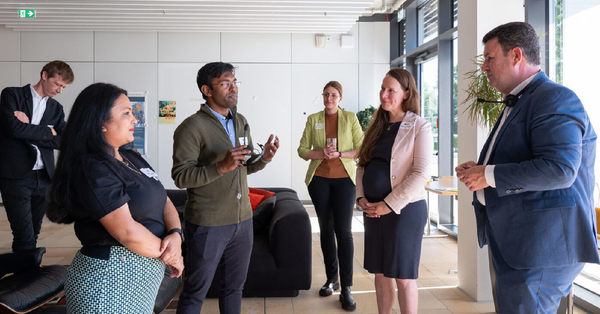Christoph Keplinger joins the Max Planck Institute for Intelligent Systems as new Director
With the appointment of the 36-year old Austrian, the Max Planck Society has attracted a world-renowned scientist whose background and expertise perfectly complement and extend the research at MPI-IS and within the Cyber Valley ecosystem

Stuttgart – The Max Planck Society has appointed Christoph Keplinger as a director at the Stuttgart location of the Max Planck Institute for Intelligent Systems (MPI-IS). He will lead the newly established “Robotic Materials” department to pursue research on soft robotics, functional polymers and energy capture – three interrelated areas that are critical to robotic materials, a new class of material systems that tightly integrate actuation, sensing and even computation to provide physical building blocks for the intelligent systems of the future. Keplinger joins MPI-IS from the University of Colorado Boulder in the US, where he was an Assistant Professor of Mechanical Engineering and a Fellow of the Materials Science and Engineering Program, and where he held an endowed appointment serving as Mollenkopf Faculty Fellow. He earned his Ph.D. (Dr. techn.) in physics from the Johannes Kepler University Linz in Austria, and he did his postdoctoral research at Harvard University in the US. Outside academia, he co-founded the start-up Artimus Robotics in 2018 and currently serves as its Chief Scientist.
In parallel to receiving his offer to join the Max Planck Society as a director, Dr. Keplinger was also selected for a 2021 Alexander von Humboldt Professorship at TU Dresden. He declined this prestigious appointment during the negotiations process in order to focus on his activities at MPI-IS.
“I feel honored that the Max Planck Society puts its trust in me,” says Dr. Keplinger. “I am thrilled about the prospect of true academic freedom, curiosity-driven research and the generous amount of long-term funding that comes with being a director at a Max Planck Institute. Clearly, this is a once-in-a-lifetime professional opportunity that will enable me to pursue a bold scientific agenda and to produce a higher level of creative research output than in any other institution that I am aware of. Here, I will be able to establish a large, world-leading research group in the field of robotic materials that can simultaneously address questions in the underlying materials science using tools from physics or chemistry, with lots of opportunities to collaborate with other groups on the Stuttgart campus, as well as work on new designs of robots that are based on intelligent materials systems, and that can tap into the rapidly growing toolkit from the areas of learning and perception, emerging from the Tübingen campus. Thus, my team and I can go from inventing new materials to testing these in complex robotic systems that make use of the latest discoveries in machine learning in an extremely short period of time, thereby creating a cutting-edge research ecosystem that will rapidly advance the state of the art.”
“I truly couldn’t be happier about the fact that Christoph Keplinger has joined our Board of Directors,” says Katherine J. Kuchenbecker, who heads the Haptic Intelligence Department and is currently Managing Director of MPI-IS. “Christoph started his first faculty position only five years ago but shows remarkable maturity as a scientist, a mentor, and a leader. I can’t wait to see the fundamental insights and clever innovations that he and his team create here in Stuttgart in the coming decades.”
“Prof. Keplinger is a remarkably creative and well-rounded scientist and a demonstrated leader in the robotic materials field,” says Metin Sitti, who heads the Physical Intelligence Department at the MPI-IS. “He has achieved international distinction and a reputation for scholarly excellence already very early in his independent career, with multiple highly influential publications in key areas of robotics and materials science that are critical for the future of intelligent systems.”
Challenging the status quo of how we build robots
Robots today rely on rigid components and electric motors based on metal and magnets, making them heavy, unsafe near humans, expensive and ill-suited for unpredictable environments. Nature, in contrast, makes extensive use of soft materials, such as muscle and skin, and has produced organisms that drastically outperform robots in terms of agility, dexterity, and adaptability. Christoph Keplinger’s research aims to fundamentally challenge current limitations of robotic hardware, using an interdisciplinary approach that synergizes concepts from soft matter physics and chemistry with advanced engineering technologies to introduce robotic materials that enable creation of intelligent machines that mimic the astonishing capabilities of organisms in nature.

The Robotic Materials Department at the Max Planck Institute for Intelligent Systems in Stuttgart, Germany.
For Keplinger’s first research focus of soft robotics, one central theme of research is the development of new classes of actuators – a key component of all robotic systems – that replicate the sweeping success of biological muscle, a masterpiece of evolution featuring astonishing all-around actuation performance, the ability to self-heal after damage, and seamless integration with distributed sensing. Areas of application for soft robotics will span from industrial automation, over medical and wearable robotics all the way to new types of human-machine interfaces. A second theme of research is functional polymers with unusual combinations of properties, such as electrical conductivity paired with stretchability, transparency, biocompatibility and the ability to self-heal from mechanical and electrical damage – key features for future biologically inspired robotic systems. A third theme of research is the discovery of new energy capture principles that can provide power to intelligent autonomous systems, as well as – on larger scales – enable sustainable solutions for the use of waste heat from industrial processes or the use of untapped sources of renewable energy, such as ocean waves.
“Looking at my future career here in Stuttgart, my long-term goal is to continuously push boundaries and explore new frontiers, and in particular, to completely transform the capabilities of humanity to build complex intelligent machines that rival or exceed the capabilities of organisms found in nature. I personally draw a lot of energy and excitement from envisioning the practical applications that will be triggered by the creation of new knowledge in my lab. In particular, my research program has impact on multiple areas that are directly tied to human quality of life, including aging, where wearable soft robotic devices will allow older people to maintain mobility and autonomy for longer parts of their lives, and also health, where my research will have applications in medical robotics. Our research will also make it possible to automate household chores and enable the creation of household robots based on inexpensive and adaptive robotic materials. Another important aspect we will work on is the development of intelligent material systems for use in energy, where new energy-capture principles will enable the economically viable use of untapped sources of renewable energy.
I am mentioning the exciting practical applications that will be enabled by my research because I am fully aware of the responsibility that comes with having control over a large amount of public funding. As a research leader, I will continuously strive to give back to society by creating knowledge, by stimulating prosperity through innovation and creation of startup companies, by inspiring and mentoring the next generation of emerging research leaders, and by engaging the public into the celebration of scientific progress through outreach activities. I hope that many young people from many different backgrounds will join me and my team on this exciting journey and help shape the future of robotics by introducing new concepts inspired by nature.”
With the focus on robotics materials, Christoph Keplinger perfectly complements and extends the spectrum of research at MPI-IS. With campuses in Tübingen and Stuttgart, MPI-IS combines theory, software, and hardware expertise in a single interdisciplinary center. The Stuttgart site in particular concentrates on research on physically intelligent systems such as humans, robots, and animals. The “Haptic Intelligence” department led by Katherine J. Kuchenbecker deals with robot and human interaction through the sense of touch. The “Physical Intelligence” department led by Metin Sitti aims to understand the principles of design, locomotion, control, perception, and learning of small-scale mobile robots made of smart and soft materials. These two existing departments in Stuttgart are complemented by research groups that focus on biomechanics and neurocontrol of legged robots; the interaction of optical, electric, and magnetic fields with matter at small length scales; and on research at the intersection of biology and robotics, exploring the behavioral and morphological adaptations of natural systems to achieve robust locomotion.
The Stuttgart area is a great fit for Christoph Keplinger to advance his career. Several research centers at the University of Stuttgart and the two Fraunhofer Institutes IPA and IAO are in close proximity to the Stuttgart site of MPI-IS. These academic institutions are surrounded by several of the world’s top industry players, creating Europe’s largest ecosystem in the field of artificial intelligence (AI): Cyber Valley, founded in 2016, with partners from politics, science, business and society. This partnership strengthens research and teaching in the fields of machine learning, computer vision and robotics as well as the links between these fields. “Yes, that's one thing I would like to help strengthen: Cyber Valley's efforts in robotics. There is already a strong focus on computer science and AI, and I would like to significantly expand and strengthen the area of material science and robotics. I will continuously strive to promote the close integration of basic research and the development of new applications,” Keplinger says.
About
Christoph Keplinger is Austrian and 36 years old. Before joining the Max Planck Society as a director at the Max Planck Institute for Intelligent Systems (MPI-IS), he was an Assistant Professor of Mechanical Engineering and a Fellow of the Materials Science and Engineering Program at the University of Colorado Boulder in the US, where he also held an endowed appointment serving as Mollenkopf Faculty Fellow. Before joining CU Boulder, he did his postdoctoral research in mechanics and chemistry at Harvard University in the US, and he earned his Ph.D. in physics from the Johannes Kepler University Linz in Austria. His research has been published in top journals including Science, Science Robotics, PNAS, Advanced Materials and Nature Chemistry, as well as highlighted in popular outlets such as National Geographic and on TED.com.
In November 2018, he co-founded Artimus Robotics, a spin-out commercializing the HASEL artificial muscle technology invented in the Keplinger Research Group at CU Boulder. He has served as Chief Scientist of Artimus since its founding.
Dr. Keplinger has already won many awards for his outstanding research. In 2019, he received the Young Scientist Award at the International Conference on Active Materials and Soft Mechatronics, AMSM, for “very significant contributions to the field of soft sensors, actuators, and robotics”. In 2017, he received the Packard Fellowship for Science and Engineering, one of the most prestigious awards given to early-career scientists; this award provides funding over 5 years “to think big and look at complex issues with a fresh perspective”. In 2013, he received the EAPromising European Researcher Award from the European Scientific Network for Artificial Muscles, and in 2012, he received both the Loschmidt Award from the Chemical-Physical Society of Austria as well as the Erwin Wenzl Award for his outstanding dissertation; in 2011 he received the Award of Excellence from the Austrian Federal Ministry for Science and Research.
Related Articles

IMPRS-IS Call for Applications is Now Open

Federal Minister Hubertus Heil visits Cyber Valley in Tüb...
